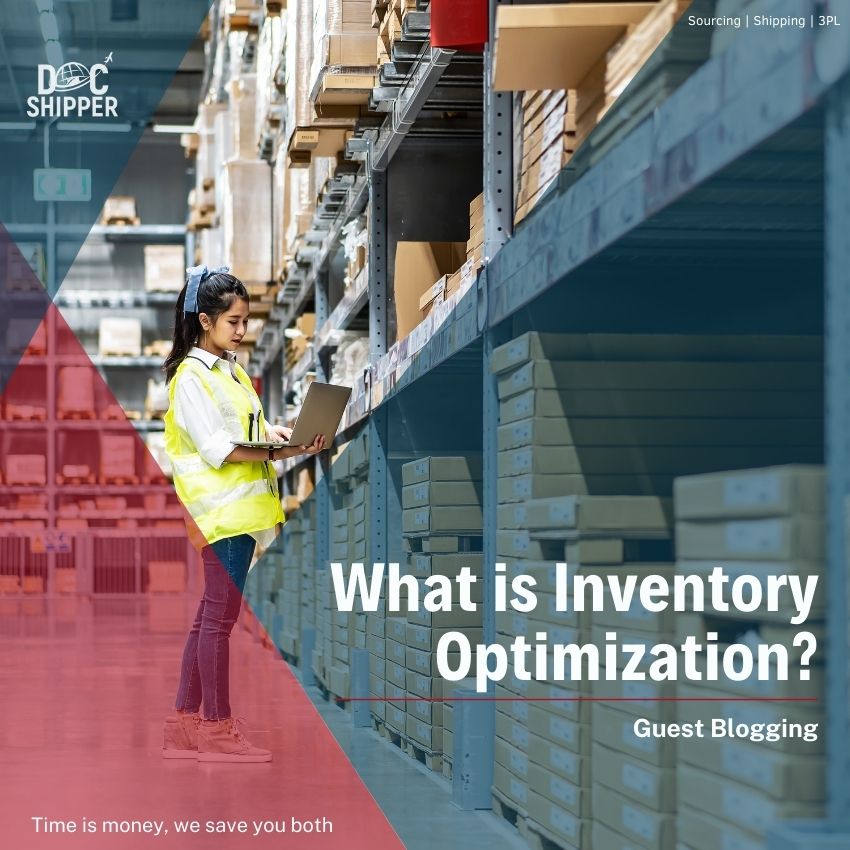Logistics companies are constantly trying to optimize their supply chain. Inventory optimization (IO) is one of the most important parts of that process. IO can be defined as “the act or process of identifying and reducing waste in the inventory system.”
Inventory optimization is one of the critical concepts in logistics. This process makes the best possible inventory configuration, considering trade-offs between costs and benefits. It can be achieved using mathematical programming, simulation or network analysis. The main goal of this process is to reduce costs and increase efficiency, safety, customer service level, and so on.
Inventory optimization can be applied at any stage of the supply chain – from raw materials’ procurement, through production, distribution and retailing. Many algorithms can optimize inventory, including order lot sizing, safety stocks, lead time reduction, and more.
Key Elements of Inventory Optimization
As you have read, inventory optimization includes all aspects of buying, storing, distributing, pricing and selling inventory to ensure that it meets customer demand while maximizing profit. There are many ways to optimize your inventory, such as by using forecast modeling techniques that provide insight into future demand and order quantities accordingly. Here are the key elements of Inventory Optimization:
Managing with data
Data is the key to successful inventory management. It is very important to avoid common inventory management mistakes for better inventory optimization. Managing data involves collecting, analyzing, and storing information about all phases of the supply chain to make better decisions about what needs to be done for future efficiency. Managing data helps ensure that orders are placed at the right time and without overspending on unnecessary products.
Improving processes
One aspect of inventory optimization in logistics is process improvement, which involves looking at old processes and figuring out how they could work better for its goals. Improving processes is significant because it ensures resource utilization and reduces costs. It can be difficult to manage inventory without a process, but it’s possible to improve your processes and increase profits with the right approach.
Driving efficiencies
With the rise of e-commerce and global markets, IO has become significant as companies look to drive efficiencies within their supply chain. Driving efficiency is one-way, logistics managers ensure their company has the most competitive edge by reducing inventory levels, increasing order fulfillment rates, and improving customer service.
Contribute with your content to inspire thousands of logistics readers through our blog. Publishing posts is a daily mission for us
Benefits of Inventory Optimization for Logistics Industry
Inventory optimization in logistics is a process that aims to maximize the use of available space and time while minimizing the number of shipments. Achieving the best inventory optimization strategy is dependent on the supply chain, demand pattern, and inventory management system in place. The key benefits of Inventory Optimization for the logistics industry are:
Increasing Customer Satisfaction
In the logistics industry, one of the most important things is customer satisfaction. This is not only because you want to keep your customers happy, but it also increases your profits when they are happy with their purchase or service. It can be difficult for a company to figure out what customers are looking for. Businesses need to satisfy customers by determining how much stock is needed and where it should be located. Inventory optimization software helps solve this problem.
Reducing Costs
By monitoring the time it takes for goods to move through your supply chain, you can reduce carrying costs such as storage charges and transportation fees. This means increased profit margins for your business. The logistics industry is always on the lookout for ways to reduce costs. Inventory optimization is one of the best ways to do this because it can reduce inventory levels, decreasing storage and handling expenses.
Inventory management can help reduce your spending on warehouse space, labor, and transport costs. It improves productivity, which reduces overtime hours and staff turnover for both driver-operators and customer service personnel at distribution centers. A Store Management Course will teach you the techniques and know-how to systematize your distribution centers or warehouses.
Improved Service Quality
Service quality is an important factor in the logistics industry. However, achieving and maintaining a high level of service is difficult because of the complexity of managing inventories and assets within these systems. Increased service quality is one benefit of inventory optimization, which can lead to increased profits for businesses such as yours. The goal for any business owner should provide customers with a high-quality service that meets their needs. Inventory optimization can help you do just that!
Major Inventory Optimization Techniques
Logistics is a complicated and time-consuming process. One of the most important aspects of logistics is inventory optimization. As we already read, IO Techniques in logistics can help you streamline your supply chain management efficiently. Here are some ways to do this:
Establish demand forecasts
Demand forecasting is a significant inventory optimization technique in logistics. Demand forecasting helps to increase accuracy in estimating future demand for products or services, thus reducing the risk of over-producing products and incurring unnecessary costs. Demand forecasts are also used as input into production planning processes to help balance the supply and demand of goods by adjusting production levels accordingly.
Keep an eye on trends that affect demand for certain products
In the ever-changing world of logistics, product demand is a major factor that affects inventory management. To keep up with trends and maintain a competitive edge in the market, businesses need to know what drives supply and demand changes. For example, investigate how changing consumer preferences drive new inventories needs and understand why prices fluctuate over time. Also, it is important to analyze industry reports about current production levels to meet the trends and demands.
Identify seasonality factors that need to be taken into account
Seasonality has a huge impact on inventory optimization in the world of logistics. Logistics managers need to consider seasonal factors such as holiday shopping rushes and high-demand periods when it comes to what they stock in their warehouses. Seasonal fluctuations will have an impact on how much product you need to carry at any given time. If you don’t account for these fluctuations, then your company could suffer from lost revenue.
Improve forecasting accuracy with better data collection methods
Forecasting is a vital part of any business, especially regarding inventory management. Forecasts allow businesses to plan for the future and make smart decisions that will prevent them from running out of products or materials. However, inefficient forecasting techniques can lead to a variety of problems for your company, including overstocking and under stocking items and not being able to meet customer demand. To avoid these issues, you should be sure to use data collection methods that are more accurate than simply relying on gut feelings or other unreliable sources.
Conclusion
The logistics industry is one of the most critical industries in the world. It is responsible for transporting goods to their destinations on time and with less chance of damage or loss. Without inventory optimization, it would be impossible for these companies to do what they need to do effectively. Luckily, many benefits come from implementing inventory management solutions into your company’s processes!

About the Author
Sujith Kumar is a professional IT Faculty having more than 18 years of experience in
Dubai. He schedules classes into facilities and provides software instructions. He
spends most of his free time learning new software skills and also interested in driving
and reading. He is now working as a trainer in Edoxi Training Institute.
Read More
You might be interested in these articles
- Coronavirus (Covid-19) impacts on import/export business
- How does Coronavirus impact international supply chain?
- 💡How to find a good product to sell?
- How to find your reliable supplier for your business? [Fair Trade Guide]
- AliExpress | Use the Chinese panacea to sell your products online
- How a sourcing strategy can rocket your margin?
Need Help with Logistics or Sourcing ?
First, we secure the right products from the right suppliers at the right price by managing the sourcing process from start to finish. Then, we simplify your shipping experience - from pickup to final delivery - ensuring any product, anywhere, is delivered at highly competitive prices.


Fill the Form
Prefer email? Send us your inquiry, and we’ll get back to you as soon as possible.
Contact us




